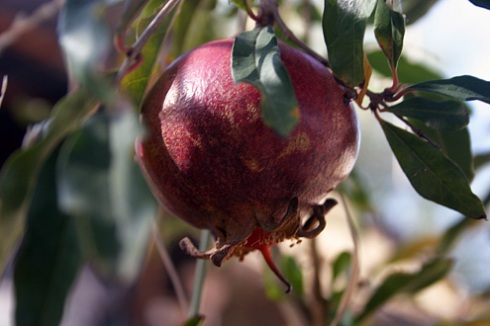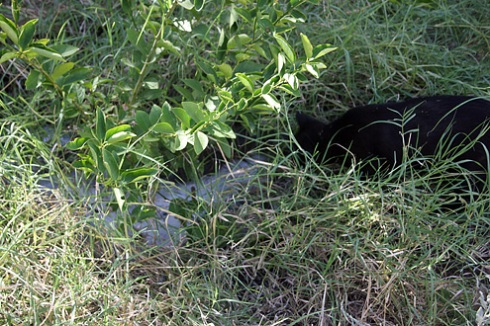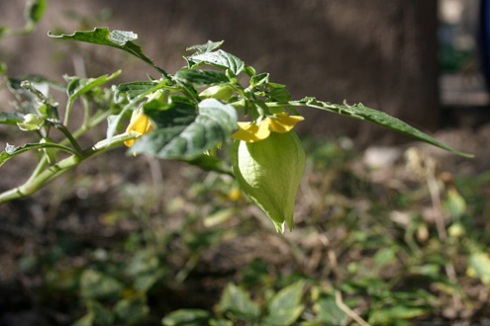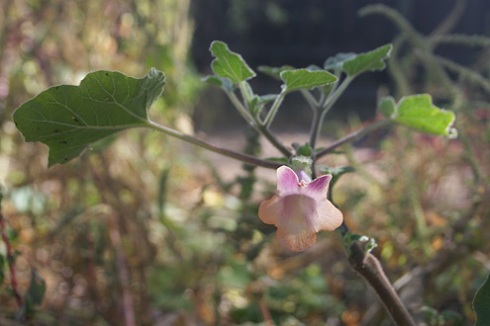You are currently browsing the category archive for the ‘Yard’ category.
We’ve been negligent with our blogging lately, as we’ve been very busy, but we have several posts in mind for the next couple of days. To help get us back into the blogging routine, here are several photos of what’s happening in our yard currently.
A ripe pomegranate on our tree.
A blooming globemallow (Sphaeralcea sp.). This beautiful native plant is common within urban Tucson, and blooms in both spring and fall. We have several globemallows scattered throughout our yard.
Hansel, our kitten, watching the graywater go from our washing machine to our small lime tree.
A small tamarind (Tamarindus indica) tree we started from seed earlier this year. Tamarind is a subtropical species which produces delicious edible pods, used worldwide to flavor a wide range of dishes. Our winters may be too cold for them to survive here, but we’re going to try to grow this tree anyway! This winter we will bring it inside the house on frosty nights, and in the spring we plan to put it in the ground in the last remaining spot in our yard suitable for a large tree.
A tomatillo (Physalis philadelphica) in our garden. I love tomatillos, and we attempted to grow a lot of them in our garden this year. Unfortunately, the plants had a really rough time: they were overshaded and then got hammered by both chrysomelid beetles and Manduca hornworms. Still, a couple of the plants are finally starting to produce a small crop of small fruits.
A green tepary bean (Phaselous acutifolius). This is one of the few crops that we consistently have success with. These beans are native to northern Mexico and southern Arizona and were grown by the ancient Hohokam people, as well as by their descendents, the modern-day Tohono O’odham. The dried beans are delicious, though they take a long time to cook. The plants do amazingly well in very harsh conditions, requiring very little water. We have a number of them scattered throughout our gardens and growing up the chicken wire fence of our chicken coop. Next year we will try to grow a lot more of them, since they are so productive. The plant pictured here is growing up a native amaranth plant (Amaranthus palmeri).
We’re not yet sure what this cucurbit is, since we planted both lemon cucumbers and melons in this part of the garden. We’ll find out soon!
The devil’s claws (Proboscidea sp.) we planted are still going strong. We’ve been pleasantly surprised by how productive they’ve been. This is another plant we will grow a lot more of next summer.
We had less success with the okra we planted. We’ve managed to keep one plant alive through the harsh summer and fall we’ve had, and amazingly it seems to be about to bloom!
We had some success with sorghum, although birds have already gotten to most of the grain.
The fall and winter garden we planted is growing very slowly. It’s been a hot and dry fall – our high temperatures are still in the upper 80’s and lower 90’s, which is almost 10 degrees above the climatological average, and it’s been very dry. Still, the plants are hanging on, and we can just about start to harvest a little bit of onions and greens.
An important component of sustainable food production systems is small-scale gardening and permaculture. Since we moved into our house two years ago we have been experimenting with different crops and horticultural techniques in order to learn how to grow our own food in a sustainable manner. Our goal has been to figure out what crops grow well under the harsh conditions of an urban yard in Tucson. Most of our gardening attempts have met with failure, but these failures have taught us a lot and we’re slowly getting better at it. To a large degree we’ve set ourselves up for failure, as we’ve attempted to grow food using minimal water and minimal external inputs of fertilizer, mulch or manure.
A devil’s claw (Proboscidea parviflora) plant in our garden, one of the few summer crops we had success with this year. The fresh green pods can be cooked like okra, the seeds inside the dried and split pods can also be eaten, and fibers from the dried pods can be used in basketry. This was an important crop to the Tohono O’odham people of southern Arizona (among others).
A food production system is only truly “sustainable” if it can be utilized forever without repeated inputs of external non-renewable resources. In the case of a garden, I consider that to mean that only on-site resources should be used, with careful attention paid to recycling materials and completing nutrient cycles. At our site we are missing two critical items which would make our garden more-or-less sustainable (though not necessarily productive): a rainwater-harvesting cistern to provide water during dry parts of the year, and a composting toilet to recycle nutrients (rather than flushing them away). We plan to address both of these constraints eventually.
We are trying to achieve the following goals for our garden (we have a very long way to go before we achieve all of these goals, but we’re making gradual progress towards them):
- Avoiding external inputs of mulch, manure, fertilizer, or other soil amendments in favor of chicken manure, compost and mulch derived on-site (status: work in progress)
- Avoiding use of synthetic biocides (status: fully achieved)
- Avoiding use of municipal water by maximizing rainwater harvesting (using berms and sunken beds to channel runoff to the garden) and minimizing evaporation (by using mulch and shade) (status: work in progress)
- Minimizing tillage of the soil to reduce erosion and promote healthy soil microflora and microfauna (status: fully achieved)
- Intercropping with a high diversity of plants to reduce disease transmission and pest infestations (status: work in progress)
- Emphasizing native crop species adapted to our local conditions (status: work in progress)
- Emphasizing perennial species (which have a number of advantages over annual crops) (status: work in progress)
- Encouraging edible native “weeds” (status: work in progress)
In the next post I will describe our new fall garden, which I finally got planted today (a couple weeks later than I had hoped!). I will use this new garden to illustrate some of the ways in which we’re trying to achieve our sustainable gardening goals.
This past weekend I visited Desert Survivors, a fantastic plant nursery in Tucson which specializes in desert-adapted plants. Most of their plants are native to the Tucson area, although we’ve gotten a fair number of non-native species from them, such as our pomegranate and fig trees. This time we were wanting native shrubs, to fill in some relatively bare areas in our yard. We’re planning to eventually write a more extensive blog post about our yard, including what plants we have and how the yard is laid out. For now, though, I want to just briefly describe the new plants we bought:
- Quailbush, Atriplex lentiformis: This species provides shelter and food to birds (including chickens), so we placed this inside our chicken yard. It’s actually replacing a quailbush which had been in a nearby spot but was killed by a combination of overshading and chicken damage (they seemed to like digging around the base of this plant). This time we placed the plant in a sunnier spot and placed large rocks around the base to thwart the chickens. As soon as the plant was in the ground the chickens began eating its leaves, so I constructed a chicken wire cage to protect it until it gets large enough to survive their aggressions.
- Saltbush, Atriplex berlandieri: I bought two of these plants in the hopes that we could use it to replace salt in our diets. We had originally intended to get fourwing saltbush (Atriplex canescens), but in a taste test at Desert Survivors A. berlandieri proved to be dramatically saltier. I know that the conditions under which the plants grow influences the degree of salt sequestration in their leaves, so it’s possible that in our yard the situation will be different. With this caveat in mind, we are hoping that the plants will remain salty, as we believe that they could meet our salt needs once they are larger. We placed one of the plants between our lime tree and pomegranate tree. These trees are irrigated with the graywater from our washing machine, so salt buildup is a potential long-term problem. The saltbush should help to mitigate this buildup somewhat. We planted the other one along our north fence, which is one of the most exposed areas of our yard. We are curious to see how the plants respond to these very different conditions.
- Fairy duster, Calliandra eriophylla: This is a common plant in the desert around Tucson. It is a small shrubby legume with beautiful pink flowers. We planted it between our fig tree and lime tree, which are in a basin bordering our flagstone patio. We hope that the fairy duster will help to fill out that area, provide some nice color, and attract hummingbirds. It should nicely complement the pink globemallow (Sphaeralcea sp.) and sacred datura (Datura wrightii) we have planted in the same area.
- Wild cotton, Gossypium thurberi: We placed several of our new plants on the northeast side of the house, in an area that we’d been using as a winter and summer garden. We haven’t had much success gardening in that spot, however, so we decided to fill it out with some native shrubs. The first thing we planted there was a wild cotton plant. This is a beautiful plant which produces small bolls of cotton. I bought this on a whim, and am glad I did, as I think it will be very nice.
- Canyon hackberry, Celtis reticulata: This species, which produces edible berries, grows to be a large shrub or small tree (up to 30′ tall). We were hesitant to plant it on the northeast side of our house, where it would be competing with a mature velvet mesquite (Prosopis velutina) and a young blue palo verde (Parkinsonia floridum). However, the guy I spoke with at Desert Survivors assured me that it would actually be an ideal location for a canyon hackberry. He said that they are often found growing intertwined with other trees in the wild. In the chicken yard we also have a desert hackberry (Celtis pallida), which does better in full sun.
- Wolfberry, Lycium fremontii: This is a thorny shrub which produces delicious edible berries. We planted one last year in the chicken yard, and it was doing great until the chickens damaged some of the roots (apparently killing half of the plant). I placed a large rock at its base to prevent future damage, and it seems to be recovering. We planted the new wolfberry on the north side of the house, near the above-mentioned palo verde. We chose this spot partly as an experiment, as it is almost exactly on the opposite side of the house from the other wolfberry. As with the saltbushes, I am curious to see how the plants respond to the different conditions (one will get more sunlight and fertilizer from chicken droppings, but the other will get more water).
- Sotol, aka desert spoon, Dasylirion wheeleri: I had always thought that this interesting plant was a species of Yucca. Sotol, it turns out, is not a yucca in the strict sense but is fairly closely-related. In any case, this is a very useful plant: it was traditionally used for food and fiber, and is still used today to make an alcoholic drink. Apparently this drink, which is also called sotol, is the state drink of the Mexican state of Chihuahua. We bought two of these plants and placed them along our north fence.
- Babybonnets, Coursetia glandulosa: This is a nice shrubby legume which produces yellow and white flowers. It grows to 20 feet tall, so we figured that it would make a nice privacy screen on our north fence, which tends to usually be exposed to our neighbors’ yard and to the street beyond. I say “usually” because the neighbors have a long thicket of oleanders which they always cut back to about 6 feet just as they get tall enough to give us some privacy. Now, I have to just come out and say it: I hate oleanders. I’m sure they’re very nice in their native habitat, but in Arizona they are planted everywhere, and I mean everywhere. They are big water hogs, they are deadly poisonous and produce allelopathic chemicals (poisoning the ground around them to prevent other plants from growing), they’re very difficult to get rid of, they’re not native, and they’re just not that attractive, in my opinion. It drives me nuts that both our neighbors to the south and our neighbors to the north have planted oleanders bordering our property. My one hope comes in the form of a virus which is apparently killing oleanders in Phoenix. May it soon show up in Tucson! I would love to see all oleanders disappear from Tucson and be replaced with native or at least useful non-native plants. OK, that’s enough oleander-bashing for this post. Maybe sometime I’ll devote a whole post to Oleander Hate. Wouldn’t that be fun?
This past weekend we found some additional sources of local food, experimented with some new foods, and did a little bit of work in our yard. All in all it was a relaxing but productive weekend.
On Saturday I visited the Native Seeds/SEARCH store, which is conveniently located near our house. Native Seeds/SEARCH is a fantastic organization, based in Tucson, which works to conserve and promote the use of plant cultivars traditionally raised by the native peoples of the southwestern U.S. and northern Mexico. Their farm is located in Patagonia, about an hour from Tucson, and although they sometimes use a small amount of pesticide on their crops, I tend to forgive them since they do so in order to preserve endangered crop varieties (Marci still holds a grudge about this, however). Roughly half of the plants we grow in our garden are derived from their seeds. At their store (located on 4th Ave.) they sell seeds, packaged foods, books on desert gardening and other topics, and crafts made by native groups.
We were hoping that many of the packaged foods at Native Seeds/SEARCH would be locally grown. From what I could gather from the people working there, however, relatively little of the food they sell is actually grown within 100 miles of Tucson (much of it comes from northern Arizona and New Mexico). Fortunately, most of their beans, many of their chiles, all of their amaranth, and many of their prickly pear products are grown locally. I bought two bags of dried beans, some guajillo chile powder (one of my favorite types of chiles), and a bag of popped amaranth. We’ve been enjoying the amaranth as a snack at night. It’s delicious mixed with olive oil, a little bit of salt, and chile powder, and tastes a lot like popcorn, though not identical.
On Sunday we visited the St. Philips Plaza Farmer’s Market (at River Rd. and Campbell Ave.). It’s usually an active market, and this weekend was no exception. There is a great variety of vendors there, selling local vegetables, fruit, nuts, herbs, honey, and meat, as well as quite a bit of non-local food and goods. We bought some local pistachios (a great find!), pears, apples, arugula, tomatoes, and bell peppers, as well as bacon and ground lamb. For lunch Marci made “BLT sandwiches” of a sort, by cooking the bacon and wrapping it inside leaves of arugula along with slices of tomato and roasted chiles. They were fantastic!
We saved the bacon grease, as it would have been a shame to waste such a useful substance. This was fortuitous because I was wanting to make flour tortillas, partly due to the inspiration of my friend Ryan, who’s been making tortillas and having good success. I mixed some of our local flour with part of the bacon grease (as a substitute for pure lard), a tiny bit of salt, and some water. After kneading the dough for a couple of minutes, I let it sit for an hour and then divided it into smaller balls. These I flattened using our “rolling pin” (actually a large wooden pestle) and dropped onto a heated comal (a flat metal cooking surface). After thirty seconds I flipped them over and cooked the other side for another thirty seconds. I was quite surprised by how well they turned out, given that this was my first time attempting to make wheat tortillas! Next time we will use more bacon grease or oil, and will try to make the tortillas thinner.
Since we had tortillas to use, we decided to cook up some vegetables and make tacos. As a filling Marci sautéed some onions and bell peppers and roasted some Anaheim chiles, tomatillos and cherry tomatoes. They were delicious.
Finally, we worked on three projects in our yard. Our chicken coop was needing some repair, so I set about fixing the chicken wire gate and the fencing. The chickens haven’t seemed interested in escaping for a while, but it seemed like a good idea to maintain the fence. I also planted some additional nopal (Opuntia ficus-indica) pads along our north fence. This is a fantastically useful plant, and we have quite a few scattered around our front and back yards. It produces edible pads and fruits, makes a great windbreak and privacy screen, and requires very little water. We planted some along our north fence a year ago and it’s done very well, due to the sunny exposure and the fact that the plants have access to the water which our neighbor dumps on his accursed oleanders just on the other side of the fence…
Finally, Marci bought some parts we’ve been needing for our outdoor shower, which we plan to put together soon. We’re already diverting the graywater from our washing machine to our fruit trees, but the trees need more water than this provides alone, so we’re planning to build the outdoor shower such that the water flows to the trees. We’re also planning to plant a grapevine or two around the shower, to take advantage of any water that isn’t effectively channeled to the trees.













Recent Comments